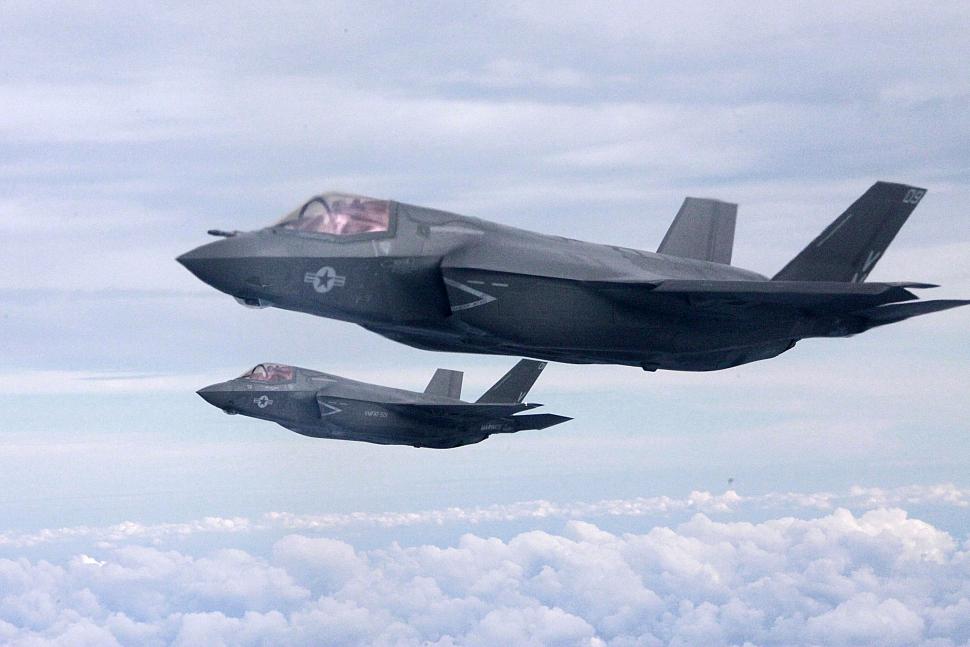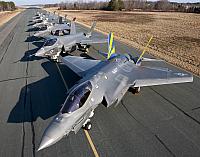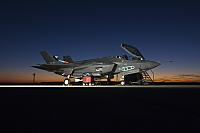Fighter Jet News
F-35 Lightning II News
The Netherlands buy 37 F-35 jets to replace F-16s
September 17, 2013 (by
Lieven Dewitte) -
The Dutch defense ministry stated today that it has formally selected the F-35 Joint Strike Fighter from Lockheed Martin to replace its aging fleet of F-16s.

The decision brings the number of countries with firm commitments to purchase the F-35 to seven after the UK, Australia, Italy, Norway, Japan and Israel also placed orders. The American military is by far the largest customer for the F-35, with more than 2,400 planes of the three different models on order at an estimated cost of $392 billion.
The Dutch, who are phasing out their F-16s by 2023, had initially planned to buy 85 F-35s, but people close to the discussions said earlier this year they wanted to scale back the order to between 52 and 68 amid deep budget cuts.
Jeanine Hennis-Plasschaert, the Netherlands’ defence minister, confirmed the purchase of 37 F-35 "Ligntning II" fighter planes in a letter sent to parliament today thus bringing an end to years of uncertainty over the Netherlands’ commitment to a program that has been plagued by technical faults, delays and mounting development costs.
The F-35 program, hit by technical faults, is several years behind schedule and 70 percent above early cost estimates.
The purchase had been long expected, as the Netherlands has been participating in the F-35 Joint Strike Fighter development program for years to secure lucrative subcontracting deals for local companies from Lockheed Martin. Most of those partners have stuck with the program despite the cost overruns that have put the plane at more than 70 percent over budget.
In an interview with Dutch state television, Ms Hennis-Plasschaert said the government had chosen the plane purely for operational reasons though. “For me as defence minister, it wasn’t so much about the business case,” Ms Hennis-Plasschaert said. “It was the plane which offered our pilots the best possibilities in the military-operational sense.”
Some Dutch politicians, concerned about rising costs, had suggested going for an alternative such as Saab's Gripen, Boeing's F/A-18 E/F Super Hornet, or the EADS Eurofighter.
The Dutch government has budgeted 4.5 billion euros ($6.01 billion) for the warplanes and an additional 270 million euros per year in operating costs.
The price of the jets would be around $85 million according to the most recent Pentagon projections though actual prices for the F-35 have been coming in about 10 percent lower than that figure, one source familiar with the program said.
The Dutch had already bought two single F-35As in low-rate initial production (LRIP) lots 3 and 4 for operational test and evaluation, but opted to store them pending this final decision to buy. The first one was transferred on July 25, 2013 to the Dutch Ministry of Defense and was the first F-35A conventional takeoff and landing (CTOL) delivered to an international partner in the F35 program.
Last week, the British defense procurement minister declined to comment on speculation that the UK might halve its total planned buy of 138 F-35Bs. The UK bought three operational test and evaluation aircraft in LRIPs 3 and 4, and plans to order 12 to 14 aircraft for its first squadron later this year.
The Netherlands Government stated that in addition to the permanent deployment for the protection of Dutch and Allied airspace, with 37 F-35s the Netherlands will continue to be able to deploy four fighter aircraft, simultaneously and continuously, to support Dutch ground troops as was done in Uruzgan and is still being done in Kunduz. In 2014, the current number of F-16s will be reduced by 7, to 61. This will reduce the investment costs involved in maintaining the F 16 for a longer period of time. The 7 aircraft will be added to the logistic reserve, to improve the deployability of the remaining 61. The deployability goals for the period up to the replacement of the F-16 will be adjusted accordingly. The F-16s and pilots stationed in the Netherlands will be divided into three squadrons.
The introduction of the F 35 should begin in 2019. The Netherlands air force will decommission the last F-16s in the mid-2020s. Volkel and Leeuwarden will both remain in operation as the two Dutch fighter air bases as the noise regulations in the Netherlands do not permit concentration of all aircraft at one air base. In 2015, however, the status of Leeuwarden will be changed from a Main Operating Base to a Deployed Operating Base. This means that the functionalities of the base will be limited to the necessary minimum. The overheads will be concentrated at Volkel Air Base.

Two F-35B Joint Strike Fighters conduct the first aerial refueling of its kind with a KC-130J Hercules in the sky above Eglin AFB on October 2nd, 2012. [Photo by Cpl. Brian Adam Jone]
The Dutch, who are phasing out their F-16s by 2023, had initially planned to buy 85 F-35s, but people close to the discussions said earlier this year they wanted to scale back the order to between 52 and 68 amid deep budget cuts.
Jeanine Hennis-Plasschaert, the Netherlands’ defence minister, confirmed the purchase of 37 F-35 "Ligntning II" fighter planes in a letter sent to parliament today thus bringing an end to years of uncertainty over the Netherlands’ commitment to a program that has been plagued by technical faults, delays and mounting development costs.
The F-35 program, hit by technical faults, is several years behind schedule and 70 percent above early cost estimates.
The purchase had been long expected, as the Netherlands has been participating in the F-35 Joint Strike Fighter development program for years to secure lucrative subcontracting deals for local companies from Lockheed Martin. Most of those partners have stuck with the program despite the cost overruns that have put the plane at more than 70 percent over budget.
In an interview with Dutch state television, Ms Hennis-Plasschaert said the government had chosen the plane purely for operational reasons though. “For me as defence minister, it wasn’t so much about the business case,” Ms Hennis-Plasschaert said. “It was the plane which offered our pilots the best possibilities in the military-operational sense.”
Some Dutch politicians, concerned about rising costs, had suggested going for an alternative such as Saab's Gripen, Boeing's F/A-18 E/F Super Hornet, or the EADS Eurofighter.
The Dutch government has budgeted 4.5 billion euros ($6.01 billion) for the warplanes and an additional 270 million euros per year in operating costs.
The price of the jets would be around $85 million according to the most recent Pentagon projections though actual prices for the F-35 have been coming in about 10 percent lower than that figure, one source familiar with the program said.
The Dutch had already bought two single F-35As in low-rate initial production (LRIP) lots 3 and 4 for operational test and evaluation, but opted to store them pending this final decision to buy. The first one was transferred on July 25, 2013 to the Dutch Ministry of Defense and was the first F-35A conventional takeoff and landing (CTOL) delivered to an international partner in the F35 program.
Last week, the British defense procurement minister declined to comment on speculation that the UK might halve its total planned buy of 138 F-35Bs. The UK bought three operational test and evaluation aircraft in LRIPs 3 and 4, and plans to order 12 to 14 aircraft for its first squadron later this year.
The Netherlands Government stated that in addition to the permanent deployment for the protection of Dutch and Allied airspace, with 37 F-35s the Netherlands will continue to be able to deploy four fighter aircraft, simultaneously and continuously, to support Dutch ground troops as was done in Uruzgan and is still being done in Kunduz. In 2014, the current number of F-16s will be reduced by 7, to 61. This will reduce the investment costs involved in maintaining the F 16 for a longer period of time. The 7 aircraft will be added to the logistic reserve, to improve the deployability of the remaining 61. The deployability goals for the period up to the replacement of the F-16 will be adjusted accordingly. The F-16s and pilots stationed in the Netherlands will be divided into three squadrons.
The introduction of the F 35 should begin in 2019. The Netherlands air force will decommission the last F-16s in the mid-2020s. Volkel and Leeuwarden will both remain in operation as the two Dutch fighter air bases as the noise regulations in the Netherlands do not permit concentration of all aircraft at one air base. In 2015, however, the status of Leeuwarden will be changed from a Main Operating Base to a Deployed Operating Base. This means that the functionalities of the base will be limited to the necessary minimum. The overheads will be concentrated at Volkel Air Base.
Related articles:
Forum discussion:
Tags
- First JSF for The Netherlands rolls out of Fort Worth ( 2012-04-04)
- The Dutch F-35 debate (updated) ( 2008-05-30)
- Two test F-35s for the Netherlands ( 2008-03-02)
- Netherlands agrees to continue JSF project ( 2006-09-30)
- F-16 News: Dutch trim F-16 fleet ( 2012-04-12)
- F-35 Lightning II news archive
Forum discussion:
- Dutch MoD choose definitely for F-35 ( 175 replies)
Tags
Additional images:

F-35B test aircraft BF-03 flown by Maj Richard Rusnok shows the weapon bay doors open exposing the GBU-32s on flight 182 on March 1st, 2012. [Lockheed Martin photo]


